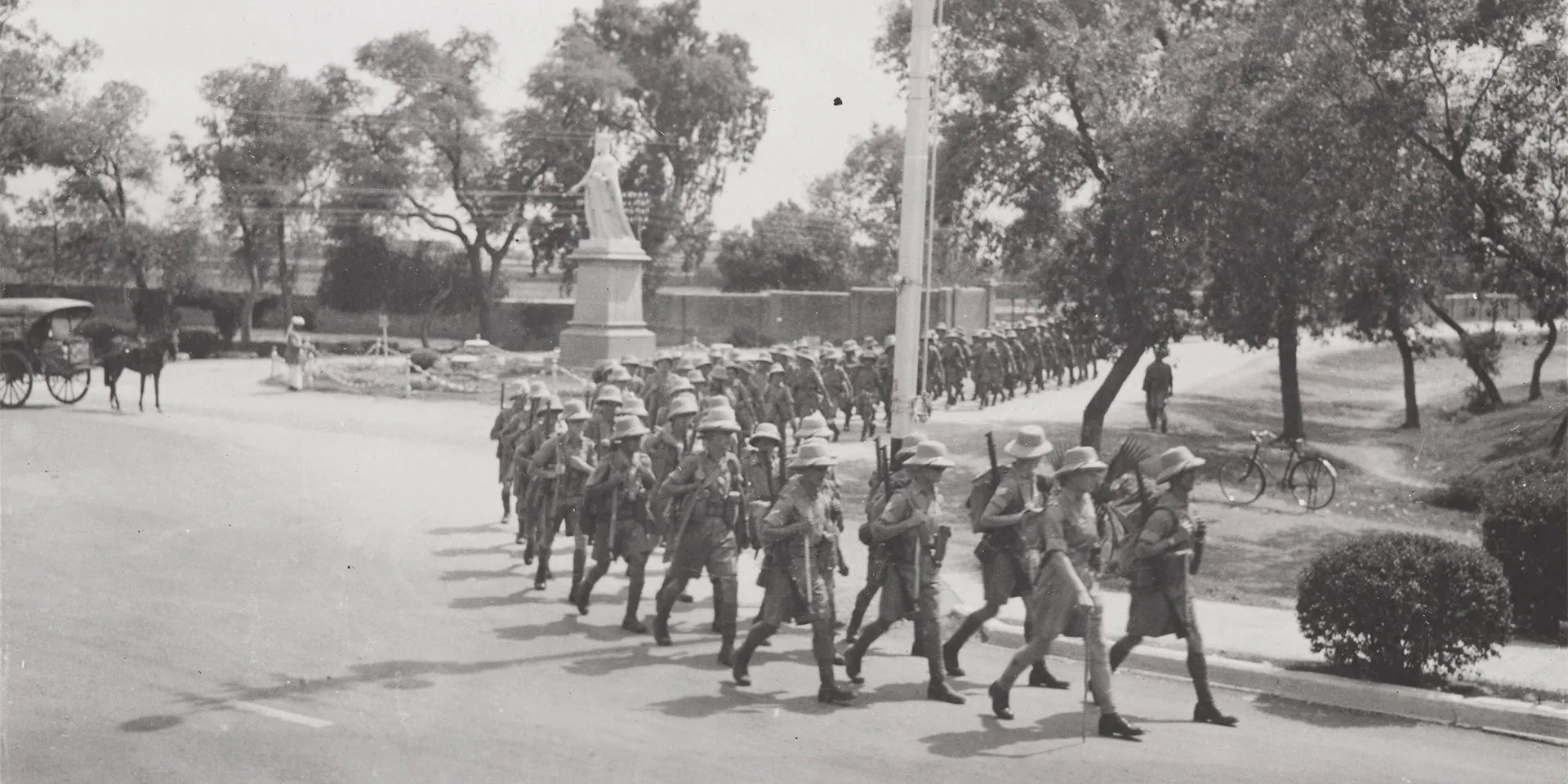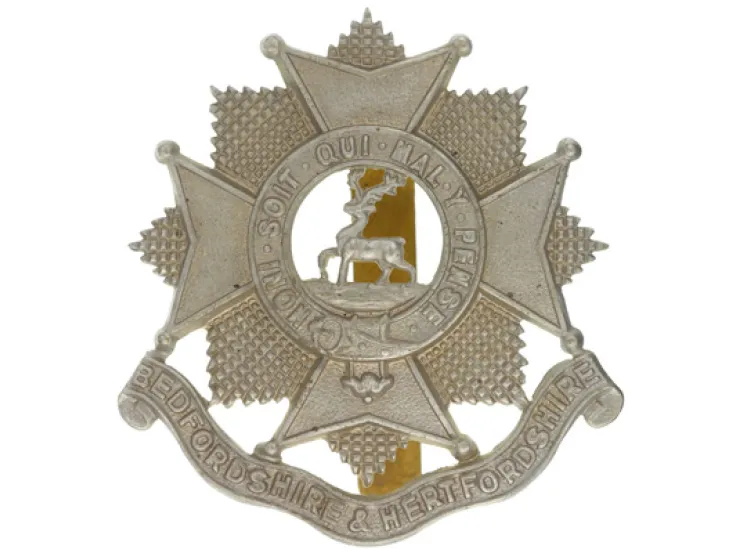
Members of 2nd Battalion, The Suffolk Regiment on the march, India, c1935
Origins
This regiment was raised in 1685 by Henry Howard, 7th Duke of Norfolk. It was one of several units formed that year to defend King James II against a rebellion led by the Duke of Monmouth.
Its recruits were predominantly from Norfolk and Suffolk, but also included a company of men who had previously been deployed to the American colony of Virginia.

Other ranks cap badge, The Suffolk Regiment, c1916

Glengarry badge, 12th (East Suffolk) Regiment of Foot, c1874
Nine Years War
Following the ‘Glorious Revolution’ (1688), the regiment found itself fighting for William III against James in Ireland, including at the Battle of the Boyne (1690).
Its attention shifted to Europe for the rest of the Nine Years War (1689-97). Its men were used as marines in raids on the French coast. Then, the whole regiment was captured by the French at Dixmude in 1695, before quickly being released through a prisoner exchange.
Early 18th century
By the beginning of the 18th century, the regiment was in the West Indies. It then saw service in Flanders and the Balearic Islands, before returning to Suffolk in 1730.
During the War of the Austrian Succession (1740-48), it took part in the final charge at Dettingen (1742) and later fought at Fontenoy (1745). Its adjutant at the time was James Wolfe, later noted for his victory at Quebec. The regiment also had spells in Portugal, Spain and Minorca during this period.
In 1751, the regiment was renamed the 12th Regiment of Foot, recognising its status as one of the oldest infantry regiments in the British Army.
Five years later, it raised a 2nd Battalion. This became a regiment in its own right, the 65th Regiment of Foot, in 1758.
Late 18th century
The 12th Foot was one of six British infantry regiments who fought at the Battle of Minden (1759) during the Seven Years War (1756-63). Its successor regiment, The Royal Anglian Regiment, continues to commemorate this victory every year on ‘Minden Day’ (1 August). The war also saw the regiment fight at Villinghausen (1761) and Wilhelmsthal (1762).
A long period of service on Gibraltar followed, including its successful defence during the Great Siege (1779-83). As a result, the regiment was granted the motto and arms of Gibraltar as part of its insignia.
In 1782, the regiment became the 12th (East Suffolk) Regiment of Foot, officially recognising its local connections. Ten years’ service in England and Ireland followed.
Revolutionary and Napoleonic Wars
In 1793, after the outbreak of the French Revolutionary Wars (1793-1802), the regiment was split. Its light-infantry flank companies were sent to the West Indies and its battalion companies to Flanders and Germany.
It regrouped the following year and was sent to India for the first time in 1796. It remained there for 12 years, capturing eight stands of colours at Seringapatam (1799) and also taking part in the invasions of Reunion and Mauritius (both 1810).
In 1812, the regiment raised a new 2nd Battalion. This only lasted six years and remained in England and Ireland for the most part, including time at Dartmoor guarding American prisoners of war from the War of 1812 (1812-15).
After the Napoleonic Wars (1803-15), the regiment spent several years rotating between England and Ireland, along with further postings on Mauritius and Gibraltar.
Victorian period
In 1842, four of the regiment’s companies split off to form a Reserve Battalion. This was sent to South Africa for the Eighth Cape Frontier War (1850-53). A draft of 57 reinforcements were aboard the troop transport 'Birkenhead' when it sank en route to the Cape in 1852.
On returning to England in 1858, the battalion was increased to full size, becoming the regiment’s 2nd Battalion. This spent half of the next 50 years in India, and the rest in Britain and Ireland.
In 1854, 1st Battalion was sent to Australia. On arrival, it helped suppress the Eureka Rebellion in Victoria and then fought in the New Zealand Wars from 1860. From there, it moved to India once again in 1867, serving in the Second Afghan War (1878-80) and on the North-West Frontier in 1888. It later served throughout the Boer War (1899-1902).
In the Army reforms of 1881, it was affiliated with the entire county of Suffolk and was accordingly renamed The Suffolk Regiment. As it already had two battalions of its own, it wasn’t merged with any other unit.
First World War
On the outbreak of the First World War (1914-18), 1st Battalion was in the Sudan. It arrived in France in January 1915, but was redirected to Salonika later that year, remaining there for the rest of the conflict.
2nd Battalion was part of the British Expeditionary Force sent to France in August 1914. It spent the entire war on the Western Front, fighting in many of the major battles.
The regiment also raised 10 Territorial, two garrison and eight New Army battalions during the conflict. These served at home stations, in France and Flanders, Galliopili and Egypt.
Interwar years
After the war, 1st Battalion had a brief spell in India and 2nd Battalion in Ireland. In 1927, 2nd Battalion moved to China and then to India two years later.
Second World War
1st Battalion was in England at the outbreak of the Second World War (1939-45). It deployed straight to France, evacuating from Dunkirk nine months later. It then remained in Britain until June 1944, when it took part in the Normandy landings and the subsequent fighting across North-West Europe.
Meanwhile, 2nd Battalion was still in India at the start of the war, guarding the North-West Frontier. It served in the Burma campaign, taking part in the fighting at Arakan and Imphal in 1944.
The Territorial 4th and 5th Battalions served on home defence duties before deploying to Egypt in 1941. They then moved east to Singapore where both were captured by the Japanese in early 1942.
After undertaking home defence duties in 1940-41, the Territorial 7th Battalion was converted into a Royal Armoured Corps unit. This went on to fight in the Tunisian campaign in 1943 before landing in Italy where it fought its way up the peninsula, ending the war on the Austrian border.
Post-war deployments
At the end of the war, 1st Battalion served in Egypt, Palestine and Greece. In 1948, it became a single-battalion regiment within the new East Anglian Brigade. Then, in 1949, it was sent to fight in the Malayan Emergency (1948-60).
Following its return home in 1953, the regiment spent its final years stationed in Trieste, in Germany with the British Army of the Rhine and in Cyprus.
Legacy
In 1959, it returned to England, where it was amalgamated with The Royal Norfolk Regiment to form the 1st East Anglian Regiment (Royal Norfolk and Suffolk). This, in turn, converted into a battalion of The Royal Anglian Regiment in 1964.
Regimental museums
The National Army Museum works with a network of Regimental and Corps Museums across the UK to help preserve and share the history and traditions of the Army and its soldiers.
Discover more about The Suffolk Regiment by visiting the Suffolk Regiment Museum in Bury St Edmunds.

















